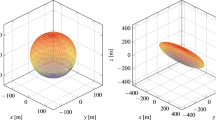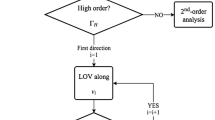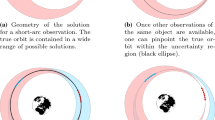Abstract
With the rapid increase in the number of space missions, the hazard of growing space debris population in important space territories like the geosynchronous Earth orbit (GEO) region deserves deeper scrutiny. One of the main challenges is to find optimal sensor tasking schemes to detect objects that are not previously cataloged. This paper introduces a method in which a so-called hypothesis surface is used to indicate valuable sensor viewing directions. The hypothesis surface is created using analytic orbit perturbation theory with crucial additions to capture resonance effects and offer sufficient accuracy for the near-Earth region. So-called hypothesis objects are analytically propagated from an early epoch to an epoch near the observation session. Their average positions over the next 24 h are used to design the hypothesis surface. Two cases are shown: (i) a validation case, where we use the hypothesis surface for detecting GEO objects currently in the two-line element set (TLE) catalog, and (ii) a survey strategy to detect high area-to-mass ratio (HAMR) objects. For a variety of observation strategies, for the validation case, we demonstrate that the hypothesis surface is successfully able to detect a large number of GEO objects.













Similar content being viewed by others
References
Erwin, R.S., Albuquerque, P., Jayaweera, S.K., Hussein, I.: Dynamic sensor tasking for space situational awareness. In: Proceedings of the 2010 American control conference, pp. 1153–1158. https://doi.org/10.1109/ACC.2010.5530989
Hobson, T.A., Clarkson, I.: Sensor-scheduling simulation of disparate sensors for space situational awareness. In: Proceedings of the advanced Maui optical and space surveillance technologies conference. Maui, HI (2011)
Linares, R., Furfaro, R.: Dynamic sensor tasking for space situational awareness via reinforcement learning. In: Proceedings of the advanced Maui optical and space surveillance technologies conference. Maui, HI (2016)
Hill, K., Sydney, P., Hamada, K., Cortez, R., Luu, K., Jah, M., Schumacher, P.W., Coulman, M., Houchard, J., Naho’olewa, D.: Covariance-based network tasking of optical sensors. In: Proceedings of the AAS/AIAA space flight mechanics meeting. San Diego, CA (2010)
Sunberg, Z., Chakravorty, S., Erwin, R.: Information space sensor tasking for space situational awareness. In: Proceedings of the 2014 American control conference, pp. 79–84. https://doi.org/10.1109/ACC.2014.6858922
Kozai, Y.: The motion of a close Earth satellite. Astronom. J. 64, 367–377 (1959). https://doi.org/10.1086/107957
Roy, A.E.: Luni-solar perturbations of an Earth satellite. Astrophys. Sp. Sci. 4, 375–386 (1969). https://doi.org/10.1007/BF00651343
Hoots, F.R., France, R.G.: An analytic satellite theory using gravity and a dynamic atmosphere. Celest. Mech. 40, 1–18 (1987). https://doi.org/10.1007/BF01232321
McMahon, J.W.: An analytical theory for the perturbative effect of solar radiation pressure on natural and artificial satellites. PhD Dissertation. Department of Aerospace Engineering Sciences, The University of Colorado Boulder, CO (2011)
Brouwer, D.: Solution of the problem of artificial satellite theory without drag. Astron. J. 64, 378–396 (1959). https://doi.org/10.1086/107958
Lane, M.T.: An analytical treatment of resonance effects on satellite orbits. Celest. Mech. 42, 3–38 (1987). https://doi.org/10.1007/BF01232946
Cook, G.E.: Luni-solar perturbations of the orbit of an Earth satellite. Geophys. J. Int. 6(3), 271–291 (1962). https://doi.org/10.1111/j.1365-246X.1962.tb00351.x
Schildknecht, T., Musci, R., Ploner, M., Flury, W., Kuusela, J., Cruz L., Palmero, F.D.: An optical search for small-size debris in GEO and GTO. In: The fifth U.S.-Russian space surveillance workshop. Pulkovo, St. Petersburg (2003)
Schildknecht, T., Musci, R., Ploner, M., Beutler, G., Flury, W., Kuusela, J., Cruz, L., Palmero, F.D.: Optical observations of space debris in GEO and in highly-eccentric orbits. Adv. Space Res. 34(5), 901–911 (2004). https://doi.org/10.1016/j.asr.2003.01.009
Frueh, C., Kelecy, T.M., Jah, M.K.: Coupled orbit-attitude dynamics of high area-to-mass ratio (HAMR) objects: influence of solar radiation pressure, Earth’s shadow and the visibility in light curves. Celest. Mech. Dyn. Astron. 117, 385–404 (2013). https://doi.org/10.1007/s10569-013-9516-5
Frueh, C., Paul, S.N., Fiedler, H.: Sensor tasking for detection and custody of HAMR objects. In: Proceedings of the advanced Maui optical and space surveillance technologies conference. Maui, HI (2017)
Frueh, C.: Realistic sensor tasking strategies. In: Proceedings of the advanced Maui optical and space surveillance technologies conference. Maui, HI (2016)
Cain, B.J.: Determination of mean elements for Brouwer’s satellite theory. Astronom. J. 67(6), 391–392 (1962). https://doi.org/10.1086/108745
Kaula, W.M.: Theory of satellite geodesy. Blaisdell, Waltham (1966)
Dormand, J.R., Prince, P.J.: A family of embedded Runge-Kutta formulae. J. Comput. Appl. Math. 6(1), 19–26 (1980). https://doi.org/10.1016/0771-050X(80)90013-3
Paul, S.N.: Orbital perturbations for space situational awareness. PhD Dissertation. School of Aeronautics and Astronautics, Purdue University, IN (2020)
Valk, S., Lemaitre, A.: Semi-analytic investigation of high area-to-mass ratio geosynchronous space debris including Earth’s shadowing effects. Adv. Space Res. 42(8), 1429–1443 (2008). https://doi.org/10.1016/j.asr.2008.02.010
Julier, S.J., Uhlmann, J.K.: A new extension of the Kalman filter to nonlinear systems. In: Proceedings of the 11th international symposium on aerospace/defense sensing, simulation, and controls. Orlando, FL (1997)
Gupta, P.L., Gupta, R.D.: Sample size determination in estimating a covariance matrix. Comput. Stat. Data Anal. 5(3), 185–192 (1987). https://doi.org/10.1016/0167-9473(87)90014-4
Wan, E., Merwe, R.: The unscented Kalman filter, Kalman filtering and neural networks. Wiley, New York (2001)
Burkardt, J.: The truncated normal distribution. https://people.sc.fsu.edu/~jburkardt/presentations/truncated_normal.pdf (2014). Accessed Oct 2021
Wilhelm, S., Manjunath, B.G.: tmvtnorm: truncated multivariate normal and student t distribution, R package version 1.4-10. http://CRAN.R-project.org/package=tmvtnorm (2015). Accessed Oct 2021
Tallis, G.M.: The moment generating function of the truncated multinormal distribution. J. R. Stat. Soc. Ser. B (Methodological) 23(1), 223–229 (1961)
Johnson, N., Kotz, S.: Distribution in statistics: continuous multivariate distributions. Wiley, New York (1972)
Lee, L.-F.: On the first and second moments of the truncated multi-normal distribution and a simple estimator. Econ. Lett. 3(2), 165–169 (1979). https://doi.org/10.1016/0165-1765(79)90111-3
Leppard, P., Tallis, G.M.: Evaluation of the mean and covariance of the truncated multinormal. J. R. Stat. Soc. Ser. C (Appl. Stat.) 38(3), 543–553 (1989)
Manjunath, B.G., Wilhelm, S.: Moments calculation for the double truncated multivariate normal density. https://arxiv.org/abs/1206.5387 (2012). Accessed Oct 2021
Kurz, G., Gilitschenski, I., Hanebeck, U.D.: The partially wrapped normal distribution for SE(2) estimation. In: Proceedings of the 2014 international conference on multisensor fusion and information integration for intelligent systems (MFI). Beijing, China (2014). https://doi.org/10.1109/MFI.2014.6997733
Little, B.D., Frueh, C.: SSA sensor tasking: comparison of machine learning with classical optimization methods. In: Proceedings of the advanced Maui optical and space surveillance technologies conference. Maui, HI (2018)
Frueh, C., Fielder, H., Herzog, J.: Heuristic and optimized sensor tasking observation strategies with exemplification for geosynchronous objects. J. Guid. Control Dyn. 41(5), 1036–1048 (2018). https://doi.org/10.2514/1.G003123
Little, B.D., Frueh, C.: Space situational awareness sensor tasking: comparison of machine learning with classical optimization methods. J. Guid. Control Dyn. 43(2), 262–273 (2020). https://doi.org/10.2514/1.G004279
Rose, M.J.: Optical sensor uncertainties and variable repositioning times in the single and multi-sensor tasking problem. MS Thesis. School of Aeronautics and Astronautics, Purdue University, IN (2020)
Park, R.S., Scheeres, D.J.: Nonlinear mapping of Gaussian statistics: theory and applications to spacecraft trajectory design. J. Guid. Control Dyn. 29(6), 1367–1375 (2006). https://doi.org/10.2514/1.20177
Author information
Authors and Affiliations
Corresponding author
Ethics declarations
Conflict of interest
On behalf of all authors, the corresponding author states that there is no conflict of interest.
Additional information
Publisher's Note
Springer Nature remains neutral with regard to jurisdictional claims in published maps and institutional affiliations.
Appendix A Analytic Expressions for the Entries of Second Hybrid Moment of a Partially Wrapped Normal Distribution
Appendix A Analytic Expressions for the Entries of Second Hybrid Moment of a Partially Wrapped Normal Distribution
where \(a=1-exp{(-C_{11})}\).
where \(b=1-exp{(-C_{22})}\).
where \(c=1-exp{(-C_{33})}\).
Rights and permissions
About this article
Cite this article
Paul, S.N., Little, B.D. & Frueh, C. Detection of Unknown Space Objects Based on Optimal Sensor Tasking and Hypothesis Surfaces Using Variational Equations. J Astronaut Sci 69, 1179–1215 (2022). https://doi.org/10.1007/s40295-022-00333-z
Accepted:
Published:
Issue Date:
DOI: https://doi.org/10.1007/s40295-022-00333-z




